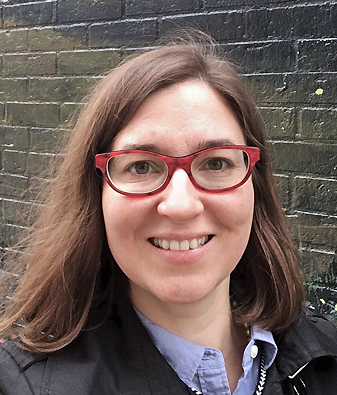Even before the COVID-19 pandemic, life was being lived increasingly in built information environments of digital tools, platforms and algorithms — including search engines, scholarly digital archives, augmented reality, the Internet of Things and more.
At the same time, awareness was growing of the cultural and social pitfalls and injustices lurking in those environments.
“A few years ago, public discourse around digital infrastructure started to shift,” says Alexandra Bolintineanu, an assistant professor, teaching stream, in the Faculty of Arts & Science’s Centre for Medieval Studies and an instructor in the digital humanities program of Woodsworth College.

“Scholars like Safiya Umoja Noble started to point out that digital infrastructure has its dangers,” she says. “Digital environments are cultural artifacts. They reflect who we are because we made them and, in turn, they make us. They change us and the way we lead our lives.”
The pandemic plunged us even further into this virtual existence as in-person activities around the world were cancelled and replaced with digital, online analogues. In universities, this meant replacing in-person classes with virtual learning platforms.
While the transformation challenged instructors and students in many ways, it also created an experiential learning opportunity to study built teaching environments through the lens of critical digital justice scholarship.
Virtual Worlds is a second-year, undergraduate digital humanities course where students study the diverse virtual environments we find ourselves in. The course is taught by Bolintineanu who, throughout her career, has explored the intersection between the humanities and computing.
The course originally included in-person learning in labs, libraries, makerspaces and museums which, of course, was curtailed by the pandemic. Bolintineanu responded to the restrictions in a number of ways, including the creation of an assignment which added Blackboard (BB) Collaborate — the teaching platform used in class at the time — to the digital environments being studied.
BB Collaborate is a web conferencing tool used in academic institutions around the world that enables remote lectures. With it, instructors create a virtual lecture hall which can include two-way audio with students, interactive whiteboards, application and desktop sharing, closed captioning, breakout rooms and video-recording of sessions.
I hope it’s helped them be more aware of their own experiences and insights as consumers of digital goods and platforms. So they can seize that agency and be able to move more intentionally through these digital systems — to be more critical of these digital worlds in which we live.
Virtual Worlds students were asked to analyze the platform, not just from a usability standpoint, but also to explore how different values and ethical principles were built into it. They were asked to reflect on their own lived experience of learning on the platform and what it revealed about how knowledge is conveyed, how learning takes place and about power dynamics in the classroom.
The results of this analysis are described in the paper BB Collaborate Under a Usability Lens: Pandemic-Inflected Experiential Learning in an Undergraduate Digital Humanities Course, published earlier this year in The Journal of Interactive Technology & Pedagogy.
The paper was co-authored by Bolintineanu, along with three undergraduate students: University College’s Jennifer Ayow, Victoria College’s Robyn Jane Carino and New College’s Emma McDonald. A fifth co-author was Komal Noor, a library user experience consultant at U of T.
Among the observations described in the paper, Ayow noted that instructors chose which content to share, sorting it into BB Collaborate’s categories: primary, secondary and interact.
“Separating primary and secondary content from interact implies that the instructor is not interacting with students when sharing their slides, whiteboard, or other primary/secondary content,” says Ayow. “This reflects a traditional lecture-style class where the professor talks ‘at’ the students with minimal student participation.”
The students also noted that instructors controlled session settings and because of this, had the power to limit who was able to share their camera feed or their screen, or speak to their classmates. They noted that instructors could censor expletives in the classroom and moderate the degree to which course material was made available.
Students also reported that the virtual classroom made it hard to separate professional and personal life — something that many workers have discovered over the past two years.
According to Carino, “The boundaries between home and work have become blurred. By not allowing its users to set virtual backgrounds to preserve their privacy and by displaying captioning that continues to transcribe speech even when a user is muted, such BB Collaborate affordances further exacerbate these issues of boundaries and privacy.”
As an example of this, the authors cite an instance when Bolintineanu paused a lesson and muted her microphone for privacy. However, her PowerPoint was still active and it transcribed, for all to see, the instructor’s question to her child, “Honey, do you want a grilled cheese sandwich?”
McDonald observed that social and financial inequalities between students meant inequalities in access. “The platform’s existence behind the increasingly restrictive paywall of postsecondary education in Canada reflects the classist privatization of knowledge,” she says. “A perspective missing from both BB Collaborate and from this analysis is that of the people who can’t afford to be here; can’t afford to benefit from the exchange of knowledge on this platform, however imperfect.”
Bolintineanu is hopeful that, as a result of the assignment, her students now have the vocabulary and concepts to better understand the digital systems through which they move, as well as their own experience within those systems.
“I hope it’s helped them be more aware of their own experiences and insights as consumers of digital goods and platforms,” she says, “So they can seize that agency and be able to move more intentionally through these digital systems — to be more critical of these digital worlds in which we live.”

